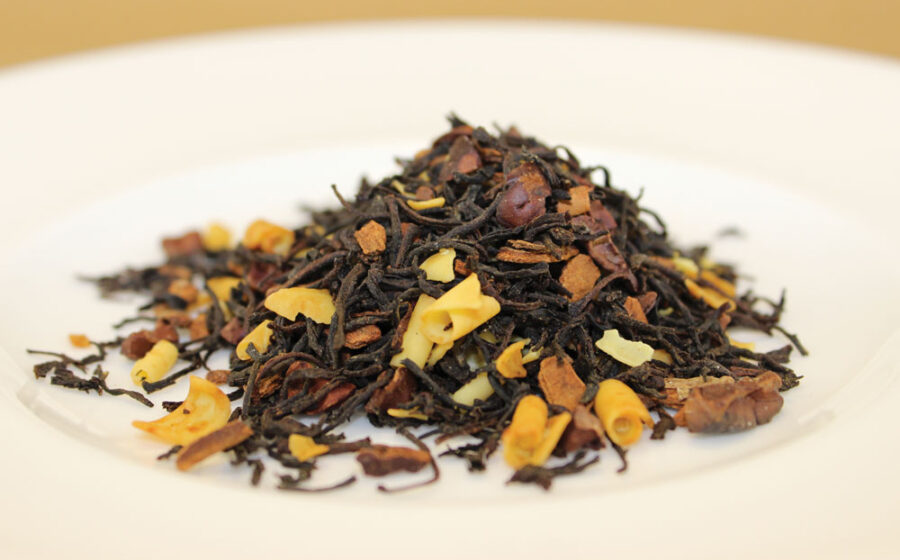[C]hocolate has been captivating the palates of humans around the world for centuries—first in its raw cacao form in the Amazon, and now in everything from sweet candy bars to culinary dishes and myriad desserts. The scientific Latin name for chocolate, Theobroma cacao, actually translates to “food of the gods.” The qualities that make chocolate such a perfect pairing for food and sweets—its rich flavor, earthiness, depth of character and subtle bite—also make it an ideal complement to many types of tea.
As Numi Organic Tea’s co-founder and CEO, as well as the chief alchemist behind Numi’s blends, I love the versatility of chocolate, both for its uses in tea and in pairings that go beyond the average chocolate bar. Almost everyone, especially in the United States, loves the taste of chocolate; it evokes feelings of both indulgence (think rich desserts or exotic dishes like molé) and familiarity (the simple, sweet taste of your favorite childhood treat). Americans are also increasingly recognizing chocolate for its energizing and healthful benefits; dark chocolate is known for its antioxidant properties and ability to produce feelings of satiety. Anecdotally, chocolate is also celebrated for its ability to ease feelings of sadness.
Numi launched its first organic chocolate tea blend, Chocolate Pu-erh, in 2008, with the rollout of our original line of pu-erh tea blends. Pu-erh is a fermented tea grown on ancient 500-year-old organic tea trees in Yunnan, China. It has a bold, earthy flavor and is smooth with slightly sweet hints of malt. Pu-erh’s rich earthiness is a natural pairing for the matching characteristics of chocolate. Both chocolate and pu-erh have strong, deep flavors and an exotic richness that is unsurpassed by other ingredients. The blend also contains cinnamon, vanilla bean and rooibos, which help round it out and offer both complexity and harmony, along with a final twist of sweetness. It is now one of our top-selling blends.
Chocolate, like tea, comes in many varietals and has many different characteristics, both in taste and in the ways it complements other ingredients. Whether the dominant flavor of any given chocolate is earthy, sweet, bitter or vegetal, the purpose of a pairing is to either enhance or complement that flavor quality. My primary goal in creating any blend is to achieve balance and subtle nuances between all ingredients, allowing certain flavors to be more prominent and others to settle in the background of the palate. For Chocolate Pu-erh, mixing organic pu-erh tea and cocoa powder made perfect sense due to their respective depth and richness. But it still needed some complexity, so I added vanilla bean and rooibos to give it familiar hints of sweetness and then a touch of cinnamon and nutmeg to give it punch. All of this, combined with the zest of orange peel, brought it together into a divine cup of wonders. The taste is simple, but it has many nuances of warmth, home and delight. That’s what blending is really all about.
For a complementary tea-and-chocolate blend, I search for flavors and characteristics that play well together, such as a black tea with a bold character and astringency blended with chocolate mellowed by something light and creamy like vanilla. A contrasting blend pairs flavors and characteristics that are “polar” to each other but that find a balance in the final blend of ingredients. Seeking out pairings that might seem unnatural can often be surprisingly fruitful—one example of a successful coupling is a bright lemon herbal with a dark chocolate. Enhanced pairings aim for a beverage in which the sum is more than the parts.
In 2014, Numi will be launching a new line of chocolate teas, called Indulgent Tea, that lists cacao as its first, dominant ingredient. This collection is meant to celebrate two of humanity’s most revered traditions, tea and cacao, and represents the perfect harmony of these two gifts of nature. I have created four blends for the Indulgent Tea line: Chocolate Rooibos, a sensual, soothing blend of smooth South African rooibos, real vanilla beans and cacao; Chocolate Mint, a sweet balance of Numi’s Moroccan Mint, cacao and orange peel; Chocolate Earl Grey, a harmonious blend of Aged Earl Grey, creamy vanilla and cacao; and Chocolate Spice, a melt-in-your-mouth blend of rich cacao and colorful chai spices like ginger, nutmeg, cinnamon, cloves and cardamom. Unsweetened and made only with real ingredients (not “natural” or artificial flavorings), these teas can be enjoyed any time of day, whether as an alternative to your calorie-laden mocha in the morning or as a guilt-free indulgence after a meal.
This line includes pairings that cover a spectrum of tastes and provide the consumer with both an exquisite escape and a solution to sugar and budget-related dilemmas. They are both more affordable and far less calorie dense than a high-quality, organic chocolate bar or a sugary mocha, but they give the same satisfaction of consuming a rich, indulgent dessert, and they can be enjoyed throughout the day.
Chocolate is an enduring trend that continues to inspire the everyday consumer and the chef. And with new products launching every year that range from chocolate-covered beef jerky to chocolate-covered candied flowers, I don’t see chocolate’s popularity waning any time soon. Just as chocolate gives tea masters an opportunity to add texture, richness and a hint of indulgence to their tea blends, tea is also a new frontier for chocolatiers. I think we can expect to see further collaboration between both industries in the coming years, especially as tea continues to rise as one of America’s most popular beverages.
—Ahmed Rahim is Numi Organic Tea’s co-founder and CEO

















